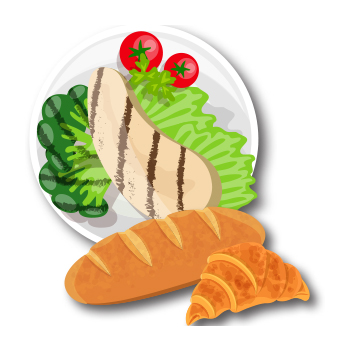


Sign-up for {N}power to get exclusive discounts, newsletters, members-only features, and more!

We talk a lot about the harmful effects of high blood sugar—and it’s true that chronically elevated blood sugar and acute blood sugar spikes are bad for health, affecting everything from brain health to immune and cardiovascular health. It’s also true that simple carbohydrates are often the culprits behind unhealthy blood sugar levels. But this is also true: We like simple carbs. They taste good. They are often the centerpiece of celebrations. Some, like corn and rice, are culturally important. The truth is that most of us are not likely to completely cut them out. That’s where these (very easy, very doable) hacks come in.

Before we get to the hacks, a little science. Glucose is a type of sugar and is one of the main sources of fuel for our cells. While our bodies can make glucose via the liver, most glucose comes from the food we eat. Glucose is an important fuel for the body, but becomes problematic in excess. Excessive glucose (the standard American diet is high in carbohydrates and tends to supply an excessive amount of glucose for most people) damages proteins and fats in the body, causing inflammation and oxidative damage. Overtime, this can lead to poor skin health, wrinkles, and accelerated aging,1 and the development of chronic diseases like cardiovascular disease, dementia, including Alzheimer’s, arthritis, type-2 diabetes, cancer, and even all-cause mortality.2 3 4 5 6
Keeping blood sugar balanced is so important to health that our bodies have a tightly regulated system of hormones to ensure levels stay within a very narrow range. When we eat foods that contain carbohydrates, blood glucose levels rise and the pancreas responds by releasing insulin, the hormone that directs glucose into cells to be burned for energy or stored as glycogen or fat for future use, and blood sugar levels are restored to a normal range. The system works great when you follow a generally low-carb diet and only occasionally indulge in refined and starchy carbs; but when every meal is built around simple carbs like bread, pasta, bagels, white rice, tortillas, etc.—foods that are rapidly digested and converted into glucose, leading to sharp spikes in blood sugar—the system can become overwhelmed trying to keep up and over time, becomes dysregulated.
And a LOT of Americans are living with dysregulated blood sugar. The most recent numbers from the American Diabetes Association show that nearly 40 million Americans have type-2 diabetes, while close to 100 million have prediabetes, blood sugar levels that are higher than normal, and without intervention, can progress to type-2 diabetes.7 Research using continuous glucose monitoring (just what it sounds like—continuously measuring a person’s blood sugar throughout the day) has revealed that many people who are considered to have normal blood sugar by standard measures actually experience “frequent elevations in blood glucose levels into the impaired … or diabetic range.”8
What’s becoming increasingly clear is that sharp spikes in blood sugar after eating are bad for health, and they are extremely common, even among healthy people. The best way to maintain optimal blood sugar balance is to limit your intake of refined and high-starch carbs and focus on eating fiber-rich vegetables, quality proteins, and healthy fats at each meal—foods that are digested slowly, helping to prevent glucose spikes.9 10 But here’s where we revisit that truth from earlier: refined carbs taste good, we enjoy eating them, and most of us are not going to completely give them up. Enter, blood sugar hacks! These super easy hacks go a long way to support a healthy blood sugar response after eating.

When you sit down to eat, you likely don’t think about the order in which you eat your food, but you should! Studies have found that eating vegetables and protein first and saving the high-starch/refined carbs for last in a meal supports a healthy post-prandial blood sugar response.11 12 13 The newest of these studies found that eating the vegetable and protein components of a meal before the high-carb food resulted in a 40 percent reduction in blood glucose and a 31 percent reduction in insulin 30 minutes after eating compared to the carbs-first meal. The test meal included white rice, grilled chicken, and a cucumber, tomato and lettuce salad with lemon olive oil dressing.14 This is truly one of the easiest hacks, requiring little effort with a big payoff.

Do you regularly take a walk after lunch or dinner? Then you’re already taking advantage of this hack! Our muscles do an incredible job of absorbing and utilizing glucose that’s floating around in the bloodstream, so put them to work after you eat! A 2023 review of eight randomized controlled trials found that physical activity after eating supports a healthy blood sugar response. Best results are seen when you move your body within 30 minutes after eating and walk at a light-to-moderate pace for at least 15 minutes. Research has also shown that small walking and standing breaks throughout the day (for as little as two minutes at a time) have a beneficial effect on blood sugar as well.15 16
Do you love potato salad or fried rice? This hack’s for you! Research has shown that when high-starch carbs, such as rice or potatoes, are cooked and then cooled before eating they create resistant starch, which acts like fiber, slowing digestion and preventing blood sugar spikes.17 It also works when the food is reheated (i.e., cooked, cooled, reheated).18

Breakfast is touted as the most important meal of the day, but a lot of people go straight for the high-carb, high-sugar breakfasts. This is the worst kind of meal to start the day—one of the studies mentioned earlier found that a breakfast of corn flakes and milk elevated blood glucose levels to the prediabetic range in 80 percent of healthy people.19 When you eat refined carbs on an empty stomach, they will be quickly digested and converted into sugar, creating your first spike of the day, setting you up for poor blood sugar balance all day. stInstead, enjoy a protein-rich breakfast, which research has shown not only reduces your post-breakfast glucose spike, but also reduces blood sugar spikes after lunch and dinner too, helping to maintain a steady balance all day long.20 If you must have your toast, “dress” it with a protein (another easy hack!), such as an egg or peanut butter, which will slow the rate of gastric emptying, thus slowing the blood sugar response.21 22



Sign-up for {N}power to get exclusive discounts, newsletters, members-only features, and more!